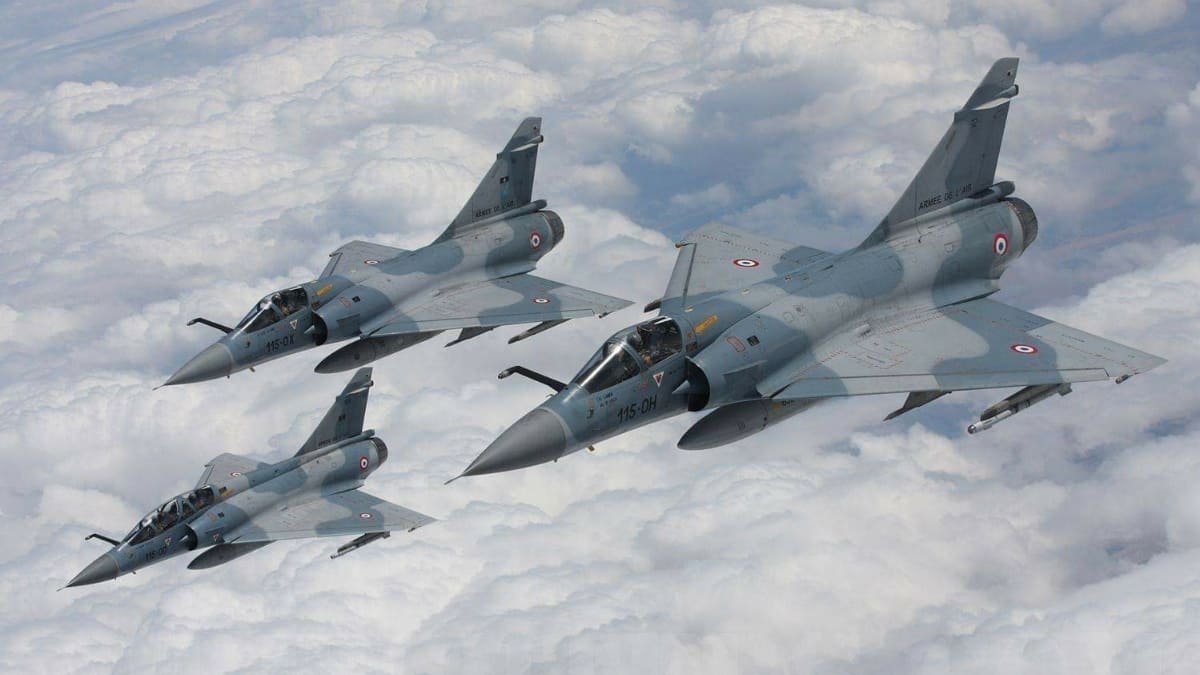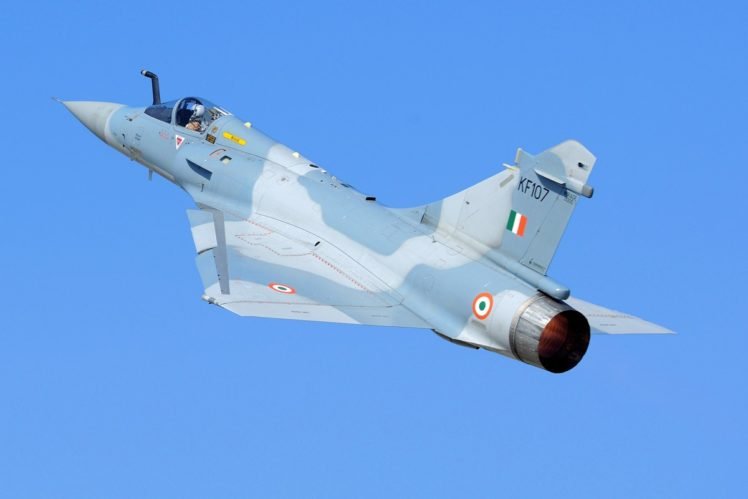Ace Of The Indian Air Force: Dassault Mirage 2000 “Vajra”

Being the fourth largest and one of the most professional Air Force in the world is not a simple task. The Indian Air force has maintained this status for a very long time and has been touching the sky with glory since 1932. the machines and men and women behind them make the Indian Air force what it is today.
In today’s article, we are going to discuss one of these mean machines- The Dassault Mirage 2000 also known as the “Vajra” ( Thunder in Hindi/Sanskrit)
Mirage 2000

Mirage 2000
The Dassault Mirage 2000 is a French multirole, single-engine fourth-generation jet fighter manufactured by Dassault Aviation. It was designed in the late 1970s as a lightweight fighter to replace the Mirage III for the French Air Force. The Mirage 2000 evolved into a multirole aircraft with several variants developed, with sales to a number of nations. It was later developed into the Mirage 2000N and 2000D strike variants, the improved Mirage 2000-5, and several export variants. Over 600 aircraft were built and it has been in service with nine nations.
The Indian Air force operates 49 mirage 2000s in three squadrons:
- Squadron number 1: The tigers
- Squadron number 7: Battle Axes
- Squadron number 9: Wolfpack

Squadron number 1: The tigers 
Squadron number 7: Battle Axes 
Squadron number 9: Wolfpack
History of procurement
In 1980, the Indian Air Force learned that Pakistan had successfully approached the US that year to purchase F-16A/B aircraft, delivery of which was to commence in 1982. The IAF immediately convinced the Indian government in late 1980 to purchase an equally potent aircraft, as its fleet of MiG-21s and MiG-23s were no match for the F-16 in any aspect. When evaluating the Mirage F-1 earlier, they became aware of a high-performance prototype of the Mirage 2000 in the flight testing phase. There were no other aircraft of this potential in the offering.
An internal assessment of the Mirage 2000 was carried out and the Indian Govt felt that the French plane was a more advanced and superior response to the F-16s that the US was to supply to Pakistan and approached France for 150 Mirage 2000. In October 1982, the country placed an order with Dassault for 36 single-seat Mirage 2000Hs and 4 twin-seat Mirage 2000THs (with H standing for “Hindustan”) with the possibility of a follow-on purchase of nine aircraft (eight single and one twin-seater aircraft) as war, maintenance and attrition reserve.
The purchase of 150 aircraft, could well have paved the way for joint production with Hindustan Aeronautics Limited, but the number of aircraft ordered (40+9) was too small for such an arrangement. India nevertheless had the option to produce a number of Mirage 2000s under a license that was later scrapped due to the country’s close relationship with the Soviet Union. This led to the induction of the MiG-29 instead, overriding reservations expressed by the IAF.
When Mirage Proved Its Worth
The newly inducted mirage didn’t have to wait long to prove its worth. Very soon after its induction, it got the opportunity. In 1999, when the Kargil War broke out, the Indian Air Force was tasked to act jointly with ground troops on 25 May. The code name assigned to their role was Operation Safed Sagar and the Mirage 2000 flew its first sortie on 30 May. This multi-role aircraft, the most advanced in the IAF, performed remarkably well during the whole conflict in the high Himalayas. Mirage bombed the enemy bunker with pin point accuracy with its laser guided bombs. Mirage proved to be a game changer in kargil war.
During Operation Safed Sagar from May to July 1999, the two Mirage squadrons flew a total of 514 sorties with only three dropouts. No. 1 Squadron flew 274 air defence and strike escort missions, while No. 7 Squadron conducted 240 strike missions during which it dropped 55,000 kg of ordnance.
Operation Parakram
During operation Parakram (India’s response to the 2001 parliament terror attacks) the mirages played a vital role. On 29 July 2002 for the first time after the end of Kargil war, India used air power to attack positions held by the Pakistani forces at Loonda Post on the Indian side of the Line of Control in the Machil sector. Eight IAF Mirage 2000 H aircraft dropped precision-guided bombs weighing 1,000-pounds to destroy four bunkers that were occupied by Pakistan. 30+ confirm KIA on Pakistani side were reported.
Balakot Air Strikes
On 26th February 2019, IAF’s mirage 2000 made history. At 0300 hours twelve non-upgraded Mirage 2000 aircraft crossed the LoC silently and bombed the heart Jaish-e-Mohammed training camp in Balakot, Pakistan. This engagement was the first time since the 1971 war that Indian fighter jets had entered Pakistani airspace. All aircraft were armed with one Israeli Spice 2000 (one-tonne) bomb. Pulwama was avenged. A large number of terrorists were given direct tickets to hell.
Technical Specifications
| Crew | 1 for mirage 2000H/I 2 for mirage 2000TH/TI |
| Length | 14.36 m |
| Wingspan | 9.13 m |
| Height | 5.2 m |
| Max takeoff weight | 17,000 kg |
| Powerplant | 1 × SNECMA M53-P2 afterburning turbofan engine, 64.3 kN (14,500 lbf) thrust dry, 95.1 kN (21,400 lbf) with afterburner |
| Maximum speed | mach 2.2 at high altitude |
| Approach Speed | 140kt (259km/h) |
| Maximum Climbing Speed | 60,000ft/min |
| Time to climb to 36,000ft / Mach1.8 | 5 minutes |
| Operational Ceiling | 55,000ft |
| Range | 1,550km |
| Ferry Range | 3,335km |
Mirage 2000H/TH cockpit
Mirage 2000 is available as a single-seater(H) or two-seater multirole fighter(TH). The aircraft has hands-on throttle and stick (HOTAS) control. Mirage 2000 incorporates the Thales VEH 3020 head-up display and five cathode ray tube multifunction advanced pilot systems interface (APSI) displays.
The combined head-up / head-level display is collimated at infinity and presents data relating to flight control, navigation, target engagement and weapon firing. Sensor and system management data is presented on two-coloured lateral displays.
SNECMA M53-P2 turbofan engine: Mirage’s Heart
Mirage 2000 is equipped with a SNECMA M53-P2 turbofan engine, which provides 64kN thrust and 98kN with afterburner. The air intakes are fitted with an adjustable half-cone-shaped centre body, which provides an inclined shock of air pressure for highly efficient air input.
Radar
The Indian Mirage 2000 uses the French RDY-2 Radar developed by Thales group. It has maximum detection range of 120 Km for 5 meter square RCS target. It can track 8 target and engage 4 simultaneously. This comes with a synthetic aperture mode which enables it to perform ground targeting roles.
Electronic Warfare suite
Mirage 2000 uses ICMS MK 3 as its electronic warfare suite.
Targeting pod
Initially, the French ALTIS 2 pods were planned but later rejected as it was incapable of operating at very high altitudes. The Israeli Litening pods were integrated. LITENING targeting pod is an advanced precision targeting pod system currently operational with a wide variety of aircraft worldwide. LITENING significantly increases the combat effectiveness of the aircraft during the day, night and under-the-weather conditions in the attack of the ground and air targets with a variety of standoff weapons.
Weapons
Mirage 2000 has nine hard points for carrying weapon system payloads: five on the fuselage and two on each wing. The single-seat version is armed with two internally mounted, high-firing-rate 30mm guns.
Air-to-air weapons include the MICA BVR and IIR air-to-air intercept and combat missiles, and the Magic 2 combat missiles, both from MBDA. MICA supports a maximum operating range of 60km. MICA IIR uses imaging infrared technology which ensures 90% kill rate.
The aircraft can carry four MICA missiles, two Magic missiles and three drop tanks simultaneously. The Mirage 2000 can fire the MBDA Super 530D missile or the MBDA Sky Flash air-to-air missile as an alternative to the MICA missile.

MICA IIR and BVR
Mirage 2000 is also equipped to carry a range of air-to-surface missiles and weapons, including laser-guided bombs. These include the MBDA BGL 1000 laser-guided bomb, MBDA AS30L, MBDA Armat anti-radar missile, MBDA AM39 Exocet anti-ship missile, MBDA rocket launchers, MBDA Apache stand-off weapon, and the stealthy cruise missile, SCALP.
Spice 2000 kits are an important part of mirage’s arsenal. The “SPICE” (“Smart, Precise Impact, Cost-Effective”) is an Israeli-developed, EO/GPS-guided guidance kit for converting air-droppable unguided bombs into precision-guided bombs. These were the directs tickets that sent several Jaish terrorists to hell on 26th Feb 2019.
The Mirage 2000I/TI upgrade
In 2004, when India made its third order for the type, the government announced its intention to upgrade its existing Mirage 2000s.
After a period of protracted negotiations for the next several years during which India and Dassault came close to signing a contract several times, India in July 2011 approved a $2.2 billion upgrade package for its Mirage 2000s. Worth some $43 million per aircraft, the upgrade would see the fleet be upgraded to Mirage 2000-5 Mk. 2 standards, with provisions made for the use of a night vision-capable glass cockpit, upgraded navigation and IFF systems, advanced multi-mode multi-layered radar, and fully integrated electronic warfare suite, among other updates.
In addition, the fleet’s inventory of Super 530D and Magic II missiles would be replaced by MICA, an order for which was placed in 2012. The first of the two IAF Mirages sent to France to be upgraded made its first flight in October 2013, marking the start of a test campaign that would encompass 250 flights, culminating in the handover of the first aircraft, redesignated Mirage 2000I, in March 2015. The new jets were redesignated Mirage 2000I for the single-seat version and Mirage 2000TI for the twin-seat version.
Also Read, Complete Details On India’s Rafale Deal
How to Identify a Mirage 2000
Mirage 2000s are difficult to spot since they are very quite and stealthy. Its engine noise is low compared to other aircraft. The engine noise is flat and consistent unlike Su 30 MKI. The low flying aircraft can be identified by its delta wing profile.
Conclusion
Dassault Mirage 2000 is one of the best and most capable aircraft of Indian Air Force. It has proved its worth time and again and will continue to do so till its last breath.

















